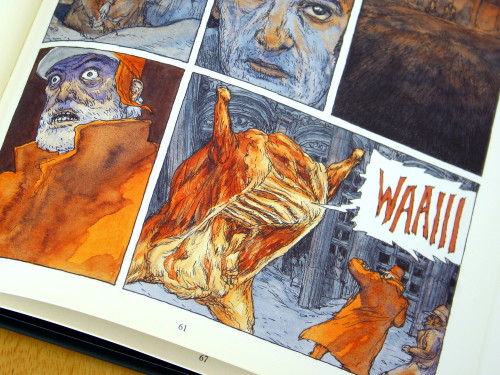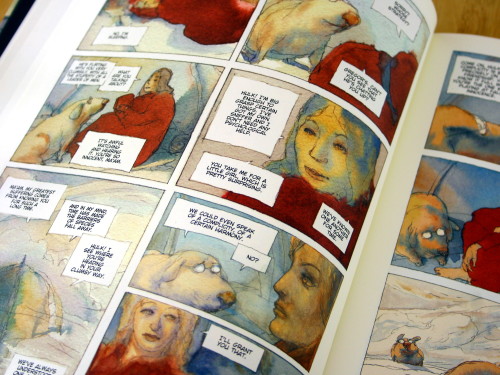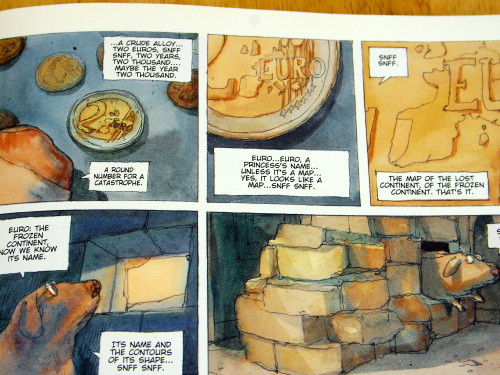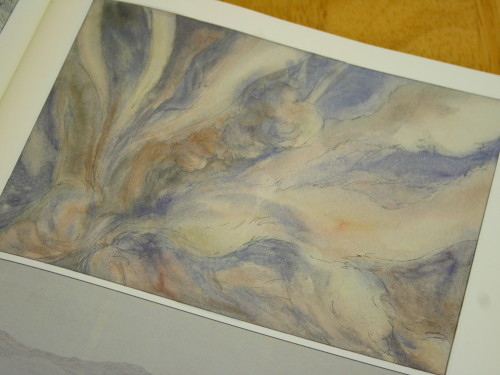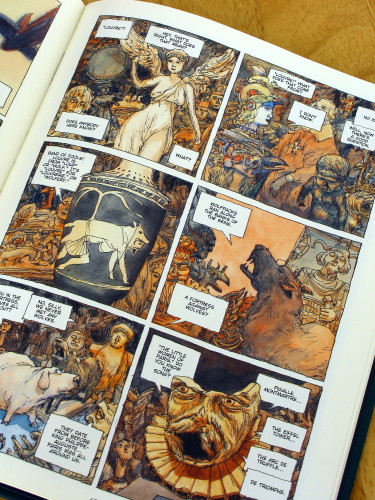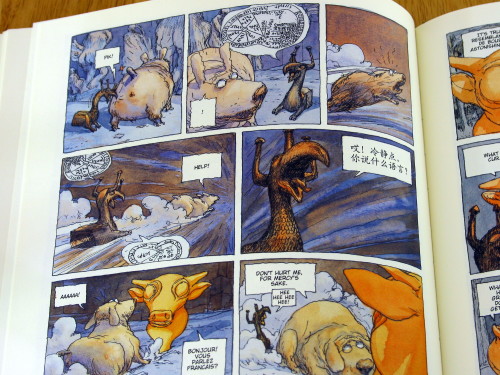Have you ever wanted to read At The Mountains of Madness, but with Baroque portraiture instead of shoggoths? How about a meditation on semiotics, historiography, and context, through the eyes (and nose) of a talking dog named after the Hulk? You have? Then golly does Nicolas de Crécy have a treat for you.
Glacial Period is de Crécy's 2005 collaboration with the Louvre, and forms part of a set of 6 or so graphic novels exploring parts of the collection. It takes his feeling that the Louvre could be overwhelming and extrudes that experience to a problem of future archaeology: faced with interpreting something so unimaginably vast and eclectic, all chains of context lost, would a team of future experts fare any better than a contemporary five year old?
The human characters do not fare so well at all. They bicker and squabble. They make amusing mistakes. The talking dog ("with a drop of pig genes...") follows his nose and seems to learn something.
The contrivance here is that Hulk's nose is so well-tuned that he can sniff out and distinguish historical epochs and fine chemical details. He is so stagily, pompously proud of this talent that it disappears into his character work, ceasing pretty promptly to feel like an expositional convenience.
And yes, the most human character is the talking dog named after "a god whom we'd concluded had been one of yours". "Yours" here referring to the museum exhibits, three thousand years of culture compressed into "past", as casually as we might say "ancient Greece". Don't worry - it's not that on-the-nose or hectoring about historical literacy. Quite the opposite, in fact. Glacial Period has a lot going on, and some of it quite clever, but it's relentlessly warm and enthusiastic.
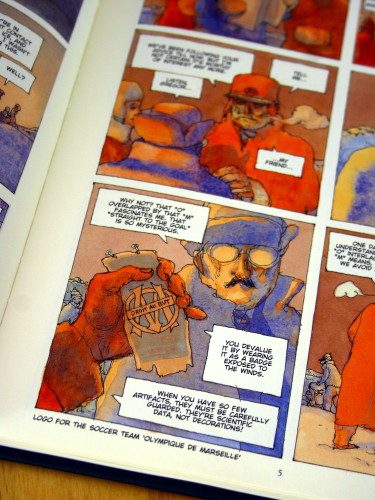 We as readers know this is a comic, we know we're looking at a talking dog, and we know what's really going on when they think of the Hulk as an old god. It's a cute early joke that invites us in on the ironic advantage the book depends on. But it is never mean. The entire premise is not that these people are idiots, simply that they are fascinatingly, absurdly wrong, and how could they not be. The next nod, two pages over (shown here), is a piece of football memorabilia parsed as a devotional icon.
We as readers know this is a comic, we know we're looking at a talking dog, and we know what's really going on when they think of the Hulk as an old god. It's a cute early joke that invites us in on the ironic advantage the book depends on. But it is never mean. The entire premise is not that these people are idiots, simply that they are fascinatingly, absurdly wrong, and how could they not be. The next nod, two pages over (shown here), is a piece of football memorabilia parsed as a devotional icon.
Not so very wrong, depending on your perspective, but also not presented with a 'make u think' smugness.
Instead, Glacial Period shows us a team of what may be experts, trekking across a lost, ice-bound continent thousands of years hence after an ecological collapse. Europe is forgotten, contextual links have barely survived. Records are sparse. They are looking for "the Metropolis", with a party of squabbling egoists and a set of maps that have all the cartographical confidence of the fly leaf of Lord of the Rings. Are they a credibly scientific expedition, or an analogue for the gentleman explorer/plunderer/collector dilettantes who built collections like the British Museum?
At its centre, Glacial Period has these five astounding pages. Our explorers try to reconstruct the history of Paris by considering the Louvre collection as though it were a single narrative account. They arrive at a kind of cartoonish lakeshore fleshpot with predatory cherubs. It is daft and glorious.
It is also a visual carnival. Three hundred years of painting, collided style-regardless and credulous like stock footage in an Adam Curtis documentary. It even has that same breathless, childlike "and then this happened" pseudo narrative that gorgeously elides its own nonsense.
De Crécy really gets to stretch his legs here, too. The whole book is movingly gorgeous, but these pages are something else. Structurally, they're the punchline/payoff to the ostensible premise of the book, the collection closeups and comic misunderstanding we've been promised. We get early and pre renaissance devotional pieces, still life, baroque dynamism, a coy rococo buttock, Bosch and Delacroix, and a little dab of Monet.
This faux-historical gloss is mirrored later by the paintings' own experience as they come to life and tell their story. This is softer, more ordered as narrative, and resting on impressionism. There are little bites taken out of a lot of styles in this book, and even within the period of the narrative, it meanders between watercolour, fidgety linework, and something bolder like gouache. It's fitting that in a piece that has the front to use big-ticket Masterpieces as throwaway panels, so many of its original panels should be arrestingly beautiful.
There's a tendentious reading there that I can't quite make stick: that the sections outside the gallery more strongly replicate for the reader the experience of viewing visual art (in a gallery) than the exhibition pieces themselves.
Running with that briefly, you could hold up the foregrounding of the paper stock and brushstrokes, the shifting overtly-painted styles, next to the incredibly casual use of renaissance paintings, and the way in the second half the massed artefacts become indistinct.
I'm not wholly sure you can sell that. It's hard for most bets not to be off once Hulk encounters the museum pieces talking. But I do think it's at least in part about how we read and experience museums and art. Worthiness isn't privileged, and there's a kind of set of wry jokes here about curation and experience.
Hulk's nose gives him a chronology, but it doesn't stop him making mistakes. Joseph seeks a narrative from the images, collaging a comic on the fly. We the readers may or may not know that the art styles he chooses don't go in that order, but the very fact that the joke doesn't depend on that knowledge means we don't get to be smug if we have it, or get to take that much comfort in context.
Nobody gets to be right except the exhibits themselves, and they aren't wholly reliable narrators. The only fact-checking is the reader's (arbitrary) level of knowledge. It's a wonderful model of coming to a vast collection and negotiating how and how much to trust the interpretation on offer.
Indeed, Glacial Period shows us two ways of reading museums, almost two experiences of curation. It's not quite this clean; the book doesn't harangue us about how to experience art. But it does face off a more proscriptive, historicist approach with something looser, more serendipitous and imaginative.
It's a trip to a museum, after all, howbeit a weird one. The premise aggressively strips back and context or expertise the characters might arrive with, so they're left with only their inclinations and approaches. Gregor has consistently been dogmatic and patriarchic. Paul has fared a little better but constantly asserts his credentials as historian while knowing little of history. The others have been more open. Joseph tells the centrepiece story, but tweaks it on the fly - there's a joy and eagerness in his attempt to interpret. Juliette balances hypotheses, and Hulk for all his precociousness asks more often than he asserts. The collection quite literally comes to life before him, and he teases out the history of the place by conversing with the artefacts.
As the book ends, Gregor is a puddle on the floor, and Paul watches quietly dumbfounded as Hulk, Juliette, and Joseph gallop off on the back of an aggressively postmodern collage in the rough form of Anubis, "a new work freed from its jewelry box."
I guess the moral of the story is that if you approach museums with flexibility, openness, and a sense of wonder, you get to ride out into a bold new life on a transcendental post-structuralist magic art dog, whereas if you're all po-faced and strict about it you get eaten by an angry beef monster?
I don't know - it goes off the rails pretty hard at the end there, but I defy you not to love it for that.
I've taken a pretty strong position here on what it's doing, but there's a lot more in Glacial Period. It's a history of the Louvre, an examination of how art means, and an amazing sketchbook. It's big and weird and utterly, utterly beautiful.


